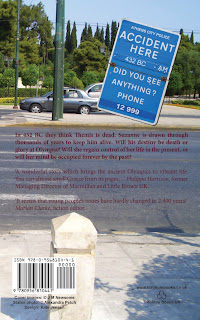Last week, Connie (my publisher) and I
presented The Boy with Two Heads to two school groups. We enjoyed our time with them, and came away with some useful feedback. Part of which was that, in some schools this autumn (2012), Year 6 is covering aspects of
Ancient Greece.

So this is a message to teachers of Year 6 History in England - and others in Classics departments everywhere:
Please take a look at my time-slip novel, The Boy with Two Heads!
I think you will find it relevant.
In my story, a modern girl 'slips' back in time to live the life of a teenage boy in Ancient Athens and Olympia during the Games of 432 BC. It's a bit spooky because he has borrowed her consciousness while she lies in a coma in 2010 ... Later in the story, he is described in an oracular prophesy as having 'two heads', hence the title.
There is a detailed and helpful review of the story by Carla Nayland here.
 I wanted my readers to feel as if they had really been to Ancient Greece. I lived in Athens for more than twenty years and so had plenty of opportunity to research and find help so as to get things as correct as possible. People who have read my book say they learned a lot painlessly! (Amazon reviews here.)
I wanted my readers to feel as if they had really been to Ancient Greece. I lived in Athens for more than twenty years and so had plenty of opportunity to research and find help so as to get things as correct as possible. People who have read my book say they learned a lot painlessly! (Amazon reviews here.)
As for relevance to the works of Homer that some schools are focusing on this year, much of life in 5th century BC Greece was similar to how it was for Homer's heroes in The Iliad hundreds of years before. The gods still intervened in every facet of human lives; men still trained hard to be soldiers and served in the army; the Olympic and other Games were still held in honour of the gods with events based on that training; war was still the norm rather than the exception.
And Homer himself is mentioned in my story. He held an important position in the culture of the time.
For instance, during a sea-voyage, the passengers
keep each other entertained by telling stories. Molon, a rather annoying young man, is one of them.
From Everyday Things in Ancient Greece
by M and C H B Quennel
The captain spent the day on the top deck, controlling the rudder. Molon lay near him, reciting Homer out loud. He told with relish of how Circe turned Odysseus’ men into pigs and made them eat acorns and chestnuts. After a while the captain asked Molon to shut up. Molon went down to the lower deck and carried on under his breath.
People who really existed also appear in the story. One is Panainos, an artist who painted huge official murals depicting the history of Athens. Themis (the fictional Boy of the title) is his apprentice and in this extract is depressed. Frog (also fictional) is Themis' body servant.
‘You need to get up,' laughed Frog. 'Panainos wants to talk to you about something important. And the food is duck and mushroom stew.’
Themis groaned and rolled out of bed.
He ate in silence while Panainos chatted on about some battle in Homer that he was going to paint when he got back to Athens.
Artist's reconstruction of Ancient Olympia, about 100 BCE.
The Altis is the area with the large temple in the middle.
‘You need a walk, my boy,’ said Panainos at last, as he stood up. ‘Come with me.’
Themis followed meekly, his mind dull and empty.
They walked towards the entrance to the Altis. It was early evening and there had been rain, so everything sparkled with drops in the slanting rays of the sun. But Themis was watching his feet as he walked on the paving stones. His sandals were getting too small.


No comments:
Post a Comment